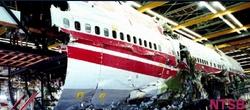All New Planes Must Include Systems Within 2 Years
 ANN REALTIME UPDATE
07.16.08 1300 EDT: Confirming earlier reports, on
Wednesday the Department of Transportation issued a mandate
requiring all new aircraft to include technology designed to
significantly reduce the risk of center fuel tank fires within two
years. In addition, passenger aircraft built after 1991 must be
retrofitted with technology designed to keep center fuel tanks from
catching fire.
ANN REALTIME UPDATE
07.16.08 1300 EDT: Confirming earlier reports, on
Wednesday the Department of Transportation issued a mandate
requiring all new aircraft to include technology designed to
significantly reduce the risk of center fuel tank fires within two
years. In addition, passenger aircraft built after 1991 must be
retrofitted with technology designed to keep center fuel tanks from
catching fire.
"We want to do everything possible to make sure safety examiners
won’t have to investigate another plane shattered by an
exploding tank," said US Transportation Secretary Mary E. Peters
during her announcement of the final rule, along with Acting FAA
Administrator Robert Sturgell. "We can’t change the past, but
we can make the future safer for thousands of air travelers, and
this rule does just that."
The Secretary -- speaking the day before the 12th anniversary of
the crash of TWA Flight 800, which prompted the requirement -- said
the new rule was needed to help avoid a similar incident. The rule
requires aircraft to have technology to neutralize or eliminate
flammable gasses from fuel tanks under the center wing of
commercial passenger planes.
Peters noted in the wake of the TWA crash researchers with the
Federal Aviation Administration developed a system that replaces
oxygen in the fuel tank with inert gas, which effectively prevents
the potential ignition of flammable vapors. Boeing also has
developed a similar system.
"Today’s rule will add another layer of safety reducing
the chance that the vapors in the tank will ignite, even if there
is a spark," added Sturgell.
NTSB Chairman Mark Rosenker also lauded the DOT's action. "The
NTSB congratulates the DOT and the FAA on this important safety
achievement," he said. "From tragedy we draw knowledge to improve
safety and today's announcement represents a significant step
toward avoiding future aviation accidents of this nature."
Acknowledging strong protests over the past decade from
airlines, which argued the system's cost was too expensive, Peters
noted the prictag of installing the new technology would range from
$92,000 to $311,000 per aircraft, depending on the aircraft's size.
Peters (below) noted that's as little as one-tenth of one percent
of the cost of a new aircraft.

US aircraft that will be retrofitted include approximately 2,730
aircraft -- including 900 Airbus A320 Family airplanes, 50 A330s,
965 Boeing 737s, 60 Boeing 747s, 475 Boeing 757s, 150 Boeing 767s
and 130 Boeing 777s.
"I recognize that this is a challenging time for commercial
aviation," Secretary Peters said. "But there is no doubt that
another crash like TWA 800 would pose a far greater challenge."
Peters made the announcement while addressing accident
investigators at the National Transportation Safety Board’s
(NTSB) Training Facility in Virginia, where remains of the TWA
Boeing are kept as an educational tool for safety
investigators.
Original Report
 0001 EDT: Using the
wreckage of TWA Flight 800 as a backdrop, the Department of
Transportation will announce Wednesday that nearly all commercial
airliners operating in the United States must be fitted with fuel
inerting devices within 10 years.
0001 EDT: Using the
wreckage of TWA Flight 800 as a backdrop, the Department of
Transportation will announce Wednesday that nearly all commercial
airliners operating in the United States must be fitted with fuel
inerting devices within 10 years.
The FAA and National Transportation Safety Board announced the
rare joint safety briefing Tuesday, but provided few details.
USA Today reports the DOT will make the formal announcement in
the Virginia hangar housing wreckage from the Boeing 747-100 that
exploded off Long Island on July 17, 1996, killing all 230 onboard.
The NTSB determined the airliner was brought down by an explosion
caused by fumes in the 747's near-empty center tank.
When it made that determination in 2000, the NTSB also stated
most other large airliners were susceptible to such explosions, and
recommended all jets be equipped with systems to stop fuel tank
fires. That plan was sharply criticized by airlines, which said
such measures would be prohibitively expensive.
A debate has raged ever since between government officials and
airline representatives. A comparatively cheaper alternative to
tank extinguishers was developed in 2002, in which tanks could be
flooded with nitrogen to prevent explosive fumes from forming...
but despite
a 2004 FAA order calling for such systems to be installed
within seven years, little has been done to enforce
that rule.
The Office of Management and Budget reportedly approved the fuel
tank rule last month, according to the paper. It will apply to all
large airliners built after 1991 in commercial service.
ANN will update this story as more information becomes
available.
 ANN's Daily Aero-Linx (04.15.24)
ANN's Daily Aero-Linx (04.15.24) Classic Aero-TV: 'No Other Options' -- The Israeli Air Force's Danny Shapira
Classic Aero-TV: 'No Other Options' -- The Israeli Air Force's Danny Shapira Aero-News: Quote of the Day (04.15.24)
Aero-News: Quote of the Day (04.15.24) Airborne 04.16.24: RV Update, Affordable Flying Expo, Diamond Lil
Airborne 04.16.24: RV Update, Affordable Flying Expo, Diamond Lil ANN's Daily Aero-Term (04.16.24): Chart Supplement US
ANN's Daily Aero-Term (04.16.24): Chart Supplement US





